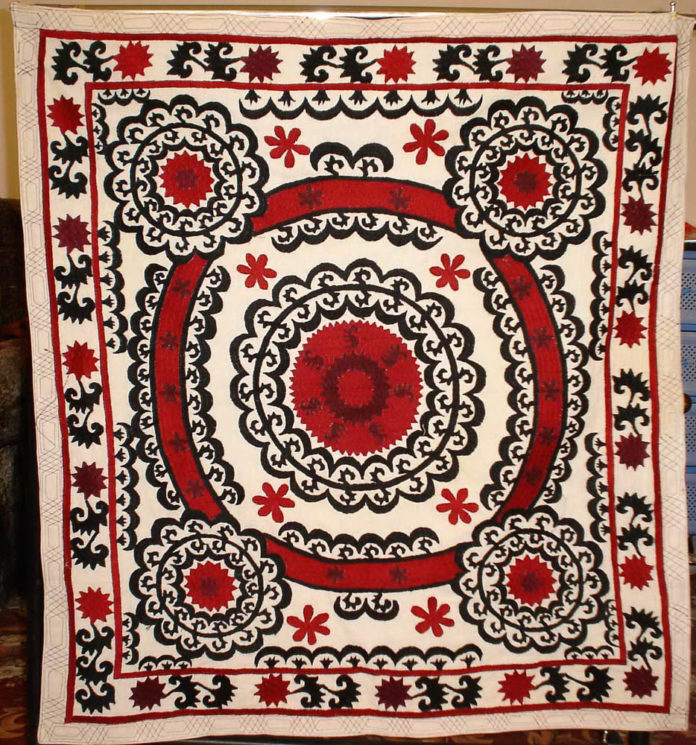Traditions of the art of embroidery of the Tajiks are rooted in antiquity. Reliable information about this has been preserved on the ancient frescos found in Penjikent, Hulbulak and Afrosiab as well as on rare pieces of fabrics from archaeological excavations.
The term suzani means “sewn with a needle”. It is derived from the word “suzan” (a needle in Farsi). The appearance of decorative embroidery pieces such as suzani were originally conditioned by everyday needs. They were items of everyday life: they covered the bed and wrapped up the bedding items, covered the cradle, etc. These embroideries, or rather textile products manufactured with the use of suzani embroidery technique, were utilitarian household items. Tajik masters embroidered suzani wall panels, zardevor ceiling friezes, borpush, kars, ruidjo covers and blankets, joynamaz prayer mats, as well as chakan dresses. The most famous among embroidered products was the large rectangular suzani wall panels.
Suzani were embroidered with colourful silk threads on velvet, silk and cotton fabrics. Threads used for embroidery were called pillya and made from local raw silk. Starting from the nineteenth century, factory made threads imported from Russia were used. Embroidery techniques such as bosma, yorma, and bigiz differed from town to town and varied in each region of Tajikistan.
Symbolically, suzani is a picture of a flowering garden. It was mainly presented at weddings. The making of wedding suzani was considered a very honourable occupation and was entrusted only to experienced craftsmen. Embroiderers always left a little piece of blank area so that the young generation of embroiderers could make an input to the unfinished creations of senior masters. In accordance with folk tradition, the unfinished pattern of suzani meant continuity of generations and the wish that weddings never cease within the family. In the ancient wedding rituals, suzani ornament was attributed to the magical powers of amulets designed to protect the happiness of young people from dark forces. The most famous were suzani embroiderers from the cities of Penjikent, Khujand, Isfara, Istaravshan, Kanibadam, Kulyab, Rasht and Gissar.
The main ornamental motif of the suzani is rosette or flowering bush in various artistic interpretation. The nature of the bush or rosette pattern can be static or dynamic. Composition of flowering bushes, as if inclined under a gust of wind, was indicative of suzani from Kanibadam area. The multi-tiered rosettes are especially typical for Istravshan’s embroideries. Unusual in colour and pattern, Pendjikent suzanis are embroidered in pink-brown colour palette. Astral motifs are prevalent in them and can be traced in the wall paintings of Penjikent of seventh and eighth century A.D. Suzani craftsmen of Kulyab, Rasht and Gissar resemble a carpet. Rosettes in them are located symmetrically and densely, with figures of birds placed between the multicoloured floral and geometric patterns. Compositionally, works of Khujant masters consist of one or several rosettes made in a saturated, contrasting colours and share border with of stitched geometric ornament.
At present, current art is in demand by the tourism and fashion industries. It decorates clothes and household items. Modern masters include Ganieva Mijgona, Sharopova Lola and Hasanova Savronbi.





